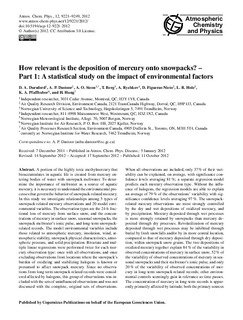| dc.description.abstract | A portion of the highly toxic methylmercury that bioaccumulates in aquatic life is created from mercury entering bodies of water with snowpack meltwater. To determine the importance of meltwater as a source of aquatic mercury, it is necessary to understand the environmental processes that govern the behavior of snowpack-related mercury. In this study we investigate relationships among 5 types of snowpack-related mercury observations and 20 model environmental variables. The observation types are the 24-h fractional loss of mercury from surface snow, and the concentrations of mercury in surface snow, seasonal snowpacks, the snowpack meltwater's ionic pulse, and long-term snowpack-related records. The model environmental variables include those related to atmospheric mercury, insolation, wind, atmospheric stability, snowpack physical characteristics, atmospheric pressure, and solid precipitation. Bivariate and multiple linear regressions were performed twice for each mercury observation type: once with all observations, and once excluding observations from locations where the snowpack's burden of oxidizing and stabilizing halogens is known or presumed to affect snowpack mercury. Since no observations from long-term snowpack-related records were considered affected by halogens, this group of observations was included with the sets of uninfluenced observations and was not discussed with the complete, original sets of observations. When all observations are included, only 37% of their variability can be explained, on average, with significance confidence levels averaging 81%; a separate regression model predicts each mercury observation type. Without the influence of halogens, the regression models are able to explain an average of 79% of the observations' variability with significance confidence levels averaging 97%. The snowpack-related mercury observations are most strongly controlled by the dry and wet depositions of oxidized mercury, and by precipitation. Mercury deposited through wet processes is more strongly retained by snowpacks than mercury deposited through dry processes. Revolatilization of mercury deposited through wet processes may be inhibited through burial by fresh snowfalls and/or by its more central location, compared to that of mercury deposited through dry deposition, within snowpack snow grains. The two depositions of oxidized mercury together explain 84% of the variability in observed concentrations of mercury in surface snow, 52% of the variability of observed concentrations of mercury in seasonal snowpacks and their meltwater's ionic pulse, and only 20% of the variability of observed concentrations of mercury in long-term snowpack-related records; other environmental controls seemingly gain in relevance as time passes. The concentration of mercury in long-term records is apparently primarily affected by latitude; both the primary sources of anthropogenic mercury and the strong upper-level zonal winds are located in the midlatitudes. | nb_NO |
